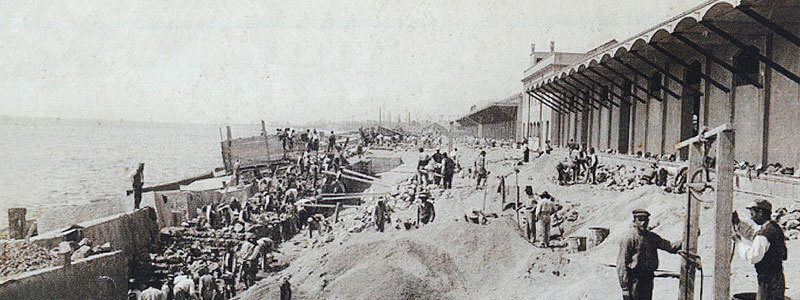The thin beige line of finely granulated stone separating Barcelona from the sea is what we know as the beach. This information is humbly provided for anyone under the illusion that Barcelona’s beach is something more. It’s not. The surface area it covers is not even a third of the space occupied by carrer Aragó, for example, that thin grey line of asphalt running parallel to the coastline a couple of kilometres inland. Like Aragó or any other urban avenue, Barcelona’s beach is an artificial construction, not hard but soft and shifty, which is why winter storms so easily wash it away. Every spring it is put back in place, in a costly operation proving just how unnatural it really is. Left to itself, the defiant ecosystem of Barcelona’s beach would probably disappear.
Before its beaches were so expertly engineered and made more accessible, it was said that Barcelona “lived with its back to the sea.” Since it lost its maritime empire centuries ago, Barcelona has spent most of its time looking in on itself, on its money-making guilds and shops and urban factories, on its elegant modernista streets and reveries of cultural eminence. Barcelonans spent more time navel-gazing than naval gazing, and it still might be true. Now the only ones who can have a yacht in Barcelona are the ultra-wealthy, as the old port is converted into the most singularly ostentatious haven for obscene luxury in the entire city. No one even cares we have an active fishing port, delivering real fresh fish, directly threatened by these obnoxious elites. Barcelona may spend more time at the beach, wading amongst the waves, but it is hard to get any closer to the sea than that.
A small watercolour at the Museu Picasso, done when Pablo was still a teen in the late 1890s, depicts a long abandoned stretch of sand lined with factory smokestacks. It was done from where the Hotel Arts is, looking up the coast. The beach is empty except for a ragged workhorse and a couple of scavengers picking away at scrap metal debris, a desolate industrial dump. Just a few years later Picasso’s Blue Period would accentuate this idea of beach as the place from where to look longingly out to sea, awash in an azure of nostalgia and ennui.
The idea that the beach might not be boring, that you might want to go for a dip, breathe the salty air, romp in the sand, then go for a cubata, is a modern construct. Urban planners have such a poor sense of how such spaces should be designed that most have taken their cue from a famous California research institute known as Baywatch. All their studies can be found online. The basic principle is that if you lay things out right, the right kind of people will come. Line the beach with palm trees and roller-skating lanes, throw in a couple of funky canteens, and the David Hasselhoffs and Pamela Andersons of the world are sure to show up, sporting crimson-red suits as they sprightly sprint by.
Another option is to forget about bathing suits altogether. “The beach be one of the best things we’ve got”, sang Jonathan Richman, “because it’s not what you have on but what you have not.” Nowadays the have-nots include pretty well every kind of person, stripped down along any section of beach, with the full-frontals in the nudist zone beyond the Mar Bella. Nowadays, too, even animals will be getting into the fun. The polemic over a new dog beach, where our canine friends might exercise their beachly rights, just shows how far our idea of leisure has come. As long as the pooches keep the music down, don’t kick up too much sand jumping for that Frisbee, and keep their poop to themselves, it shouldn’t be a problem at all.








